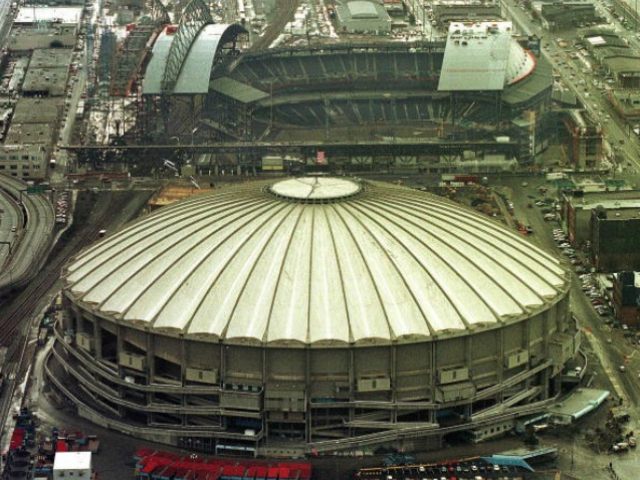The O.co Coliseum recalcitrantly stands as the last of its kind, a one-size-fits-all stadium that serves as the mi casa es su casa address of the Oakland Raiders and the Oakland A’s. Neither franchise appears happy with the communal living arrangement.
Monday night, when Angels outfielder Shane Victorino brought a panel of the left field wall down chasing a Danny Valencia double, the wisdom of dual-use venues again came into question. The Raiders hosted preseason Sunday Night Football the previous day, making the job of Oakland’s grounds crew especially rushed. After the Raiders lost to the Cardinals, the A’s lost part of the left-field wall. Advertising jingle aside, all of a sudden State Farm wasn’t there. Fans endured just a 10-minute delay but the Oakland Coliseum, site of smelly sewage floods and a foul amount of foul ground, received another black eye.
Aside from the Raiders hoping to run patterns on grass rather than through the pitcher’s mound and the A’s looking for fans through their eyes and not a telescope, spectators want a more aesthetically-pleasing park for their money. This remains more true for fans of baseball, where architecture, a natural, unpainted, green, grass surface, and dimensional quirks matter. The multipurpose monstrosities always worked better for football than for baseball, which explains why with the construction of the new Comiskey Park, Camden Yards, and other venues a quarter-or-so century ago MLB consciously built venues exclusively for its game. Baseball’s not very efficient, and neither should its stadiums be. Leave utilitarian architecture to the European Communists and American footballers.
Most cities sharing an NFL and MLB team once witnessed those teams sharing a venue. The Yankees and Giants, Indians and Browns, Senators and Redskins, Reds and Bengals, Padres and Chargers, and many more once lived, harmoniously or not, as housemates. Initially, football teams moved into baseball stadiums. The early NFL betrayed such a penchant for parasitism that teams borrowed not just fields from the more popular sport but names, too. The Cincinnati Reds, New York Yankees, Brooklyn Dodgers, and Pittsburgh Pirates all played as NFL franchises after first appearing as MLB teams. Even when the NFL teams did not outright plagiarize their names from baseball teams, they glommed on to the moniker of the MLB club that hosted them (think Fenway Park’s Redskins and Red Sox or Wrigley Field’s Bears and Cubs).
But as the NFL rose in stature, its stadiums built more for the gridiron game came to host baseball teams rather than the reverse. If baseball fans cried over the departure of Tiger’s Stadium, they lied if they said they cried over the demolitions of The Vet, Three Rivers Stadium, and Riverfront Stadium. The circular, cookie-cutter venues proved even more obnoxious with a roof atop. The Kingdome, even when serving as the backdrop to Randy Johnson’s ’80s mullet in the ’90s, the Metrodome, even as Kirby Puckett ran up its hefty-bag walls, and the Astrodome, even when its fans broke out in a “Let them play!” chant, all offended the sensibilities of any self-respecting baseball fan.
“I worked at Milwaukee County Stadium when the Packers used to play half their home games in Milwaukee,” Dave Mellor, the head groundskeeper at Fenway Park, told Breitbart Sports earlier this season. “So we had a dual-purpose NFL football and a baseball field. An important part of that (sometimes games are played during the season) there’s just a lot of attention to detail, making sure the field is ready for football, and then when the team comes back, all the edges and everything ready for the baseball team.”
Other than in Oakland, this does not happen anymore. In Toronto, the CFL’s Argonauts share the Rogers Centre with the Blue Jays. And Fenway Park, Yankee Stadium, and other baseball parks host one-off college football games here and there. But NFL and MLB franchises no longer share cramped living arrangements in a duplex stadium other than on the Bright Side of the Bay. Earth to Oaktown: it’s 2015, not 1975.
Gertrude Stein observed upon her return to her native Oakland that “there is no there there.” Even before there was no wall there, fans of the local baseball team shared Stein’s sentiment about the shared Oakland Coliseum.


COMMENTS
Please let us know if you're having issues with commenting.